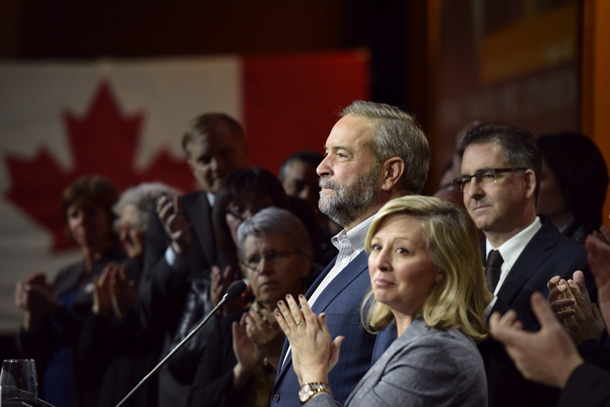The federal NDP leadership race began in earnest this weekend, with four candidates participating in the party’s first debate. While the last leadership race was about who could lead the party into government, this one seems to be about who can restore the party’s soul.
On its face, the first debate was an overly amiable affair, with the party and candidates showcasing their personalities more than their policies.
Niki Ashton is the multi-issue movement advocate. Charlie Angus is the working class storyteller. Peter Julian is affably anti-pipeline. Guy Caron is l’économiste pragmatique. Whether it’s nationalizing infrastructure, free post-secondary education or dismantling the Department of Indigenous and Northern Affairs, the first three candidates above are proposing policies that are significantly to the left of the federal NDP of the last few decades.
But if the current crop of contenders truly wants to take the party closer to its movement roots, they’ll have to address deeper issues.
There’s another NDP leadership race that is hardly being discussed. Many party stalwarts have no idea it’s happening. But in a real sense, the unacknowledged race is the one that will determine more about the fate of the party.
Call it the leadership development race. Let’s meet the contenders.
For a long time, NDP leaders have relied on a web of consultants, staffers and advisors to run things — a web that has become increasingly averse to member participation. These operatives have run campaigns in several provinces in addition to federal and municipal campaigns over the past several years.
The advice of the member-averse advisors to the leaders who hire them is usually the same: ignore most of the membership’s democratic decisions and roll out a middle-of-the-road platform that appeals to focus groups and media commentators while not offending the local power elites.
The calculation is simple: less challenging policy equals more popularity and more power. The trouble is, the member-averse strategy is on an epic losing streak. The NDP has lost elections in Nova Scotia, Saskatchewan, Manitoba and British Columbia as well as federally, in many cases snatching defeat from the jaws of victory. (The Alberta NDP’s campaign was remarkably principled and progressive for the province, but upon winning and hiring members of the member-averse into key staff positions, the government walked back promises and fell into line with the province’s oil industry.)
What’s lacking from the strategy is, at this point, painfully apparent. Seeking acceptance from the elite and media downplays the NDP’s strengths while emphasizing its weaknesses. The strategy leaves the party unable to imagine that ideas not already circulating in the media could win support. It fails to energize or grow the NDP’s biggest and most neglected asset — its base of thousands of dedicated activists.
When the new leader takes power, two pressing questions will need to be asked. First, who can they hire to replace the usual member-averse suspects? And crucially, who will develop the vital grassroots infrastructure needed to sell bold and unfamiliar ideas and win elections on a transformative platform?
The party doesn’t need one leader. It needs hundreds of new leaders.
Experienced, talented people with experience running campaigns focused on movement building (not establishment-friendly soundbites) don’t just appear. They are nurtured, and given opportunities to succeed — and perhaps more importantly, to fail. For every individual who will staff a national campaign, hundreds will have cut their teeth in local campaigns, in elections and issue-based campaigns.
The NDP’s riding associations, for example, are undermined at every turn. Worse than simply neglecting to nurture grassroots leadership development through the riding association structure, the NDP federal office tends to freeze out leaders when they do emerge. The creativity of talented members is stifled doing the bidding of centralized, tightly controlled campaigns.
And when was the last time the party as a whole mobilized its members to fight for progressive issues between elections, like Bernie Sanders is doing in the U.S. and Momentum has done in the U.K.?
Movement building by giving people the freedom to innovate and occasionally fail can be a winning strategy in more than one way. The Sanders campaign showed authentic leadership, unapologetic politics and bold policy can raise not just an army of volunteers, but a lot of money besides — one $27 average donation at a time.
If they want to change direction effectively, progressive contenders Angus, Ashton and Julian will have to address how they are going to replace the member-averse leadership and advisors and rebuild the grassroots.
History shows, however, that placing faith in a leadership candidate is not advisable. To change direction, people inside and outside the party will have to make room to talk about how they’re going to change the game — and hold future leaders accountable to that vision. ![]()
Read more: Federal Politics
















Tyee Commenting Guidelines
Comments that violate guidelines risk being deleted, and violations may result in a temporary or permanent user ban. Maintain the spirit of good conversation to stay in the discussion.
*Please note The Tyee is not a forum for spreading misinformation about COVID-19, denying its existence or minimizing its risk to public health.
Do:
Do not: